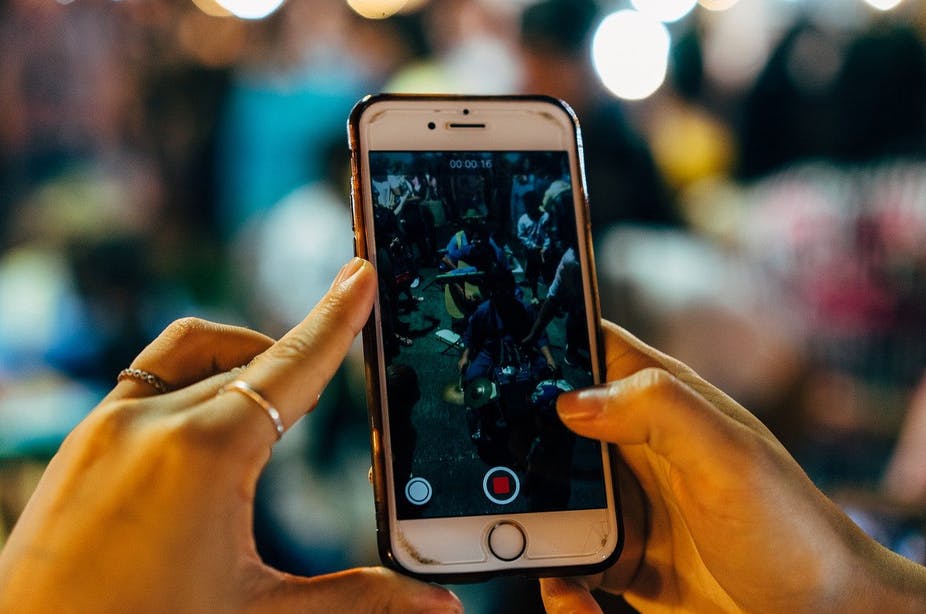At least 65% of Indonesians, or 175 million people, are connected to the internet. Nearly all of them (98%) access the internet via their mobile device and they spend around four hours a day online.
Indonesia has the the fourth-largest number of internet users in the world after China, India and the United States. The high mobile use in Indonesia has also changed the way people consume news. Unlike the generations before them, younger Indonesians no longer read newspapers and magazines, or listen to news radio. They turn to their mobile phones to get the latest news.
As the majority of Indonesians have turned to their smartphones to get news updates, local media are forced to adopt the practice of mobile journalism.
Journalism expert Oscar Westlund from Oslo Metropolitan University, Norway, defines mobile journalism as the production and distribution of news via a mobile device.
However, despite the increasing need for mobile-based news content in Indonesia, I argue that the adoption of mobile journalism practice by local media is still immature. This is due to limited human resources and poor access to the technology.
Mobile journalism in Indonesia
An associate professor of journalism at Ithaca College’s Roy H. Park School of Communication in the US, Anthony Adornato describes a “mobile-first culture” that is taking shape in many newsrooms, and Indonesia is no exception.
Many Indonesian media have shifted to mobile journalism. This includes the country’s biggest media group, Kompas.
Kompas established its online division kompas.com 25 years ago. In 2018, it created a dedicated team to develop mobile journalism.
“This is not without reason as 80% of our readers access kompas.com via mobile devices,” says Laksono Hari Wiwoho, kompas.com’s news assistant managing editor.
Kompas is not alone. A number of media have followed suit, including new media like Narasi TV, a digital television media start-up established in 2018.
Narasi TV has 14 programs distributed digitally through both its website and YouTube. Its founder, Najwa Shihab, says Narasi TV aims to produce better-quality mobile-first stories and ensure the content is mobile-friendly for viewers.
Challenges
Mobile journalism in Indonesia is still in its infancy.
Internet connectivity remains a big challenge for reporters.
“The quality of a limited internet network often slows down or stops the process of sending videos. This condition is even worse if we want to go live or to stream,” says Laksono.
Another obstacle is that interviewees, especially government officials, do not fully understand how mobile journalists work. They don’t consider news produced by small devices like mobile phones professional enough to be delivered to the public.
“Many government officials underestimate mobile journalists who want to interview with a smartphone. Mobile journalists are often accused as fake reporters, even when they equip themselves with press cards,” said Andi Muhyiddin, head of digital experience at Liputan6.com.
Liputan6.com reporters have written, taken pictures and recorded videos to produce news stories since 2019.
The quality of human resources is also a problem.
Journalists are expected to produce and share content across different platforms and at the same time to interact with audiences. But not many have these skills.
Therefore, all stakeholders in the media ecosystem in Indonesia have a lot of homework to do to realise the full potential of mobile journalism.
With the number of journalists in Indonesia exceeding 120,000 people, one of the highest totals in the Asia-Pacific region, I believe every modern journalist needs to have basic training in how to produce news with their mobile devices.
Local media associations like the Alliance of Independent Journalists and the Indonesian Journalists Association can work together to offer this kind of training to reporters. They can collaborate with universities to develop curriculum and training modules.
Mobile journalism opens new opportunities for media in Indonesia. Improving internet access, quality and affordability will be a starting point to support the development of mobile journalism.
Mobile journalism poses new challenges for media in Indonesia but what matters is the ability to adapt to the new normal.



 Jamie Dimon Signals Possible Five More Years as JPMorgan CEO Amid Ongoing Succession Speculation
Jamie Dimon Signals Possible Five More Years as JPMorgan CEO Amid Ongoing Succession Speculation  BYD Shares Rise in Hong Kong on Reports of Battery Supply Talks With Ford
BYD Shares Rise in Hong Kong on Reports of Battery Supply Talks With Ford  Proposed Rio Tinto–Glencore Merger Faces China Regulatory Hurdles and Asset Sale Pressure
Proposed Rio Tinto–Glencore Merger Faces China Regulatory Hurdles and Asset Sale Pressure  Microsoft Strikes Landmark Soil Carbon Credit Deal With Indigo Carbon to Boost Carbon-Negative Goal
Microsoft Strikes Landmark Soil Carbon Credit Deal With Indigo Carbon to Boost Carbon-Negative Goal  Micron to Buy Powerchip Fab for $1.8 Billion, Shares Surge Nearly 10%
Micron to Buy Powerchip Fab for $1.8 Billion, Shares Surge Nearly 10%  Toyota Industries Buyout Faces Resistance as Elliott Rejects Higher Offer
Toyota Industries Buyout Faces Resistance as Elliott Rejects Higher Offer  China Considers New Rules to Limit Purchases of Foreign AI Chips Amid Growing Demand
China Considers New Rules to Limit Purchases of Foreign AI Chips Amid Growing Demand  China’s AI Models Narrow the Gap With the West, Says Google DeepMind CEO
China’s AI Models Narrow the Gap With the West, Says Google DeepMind CEO  California Attorney General Orders xAI to Halt Illegal Grok Deepfake Imagery
California Attorney General Orders xAI to Halt Illegal Grok Deepfake Imagery  Rio Tinto and BHP Agree to Explore Major Iron Ore Collaboration in Pilbara
Rio Tinto and BHP Agree to Explore Major Iron Ore Collaboration in Pilbara  Syrah Resources and Tesla Extend Deadline on Graphite Supply Dispute to March
Syrah Resources and Tesla Extend Deadline on Graphite Supply Dispute to March  One Percent Rule Checklist For Safer Forex Trading Risk
One Percent Rule Checklist For Safer Forex Trading Risk  Federal Judge Clears Way for Jury Trial in Elon Musk’s Fraud Lawsuit Against OpenAI and Microsoft
Federal Judge Clears Way for Jury Trial in Elon Musk’s Fraud Lawsuit Against OpenAI and Microsoft  White House Pressures PJM to Act as Data Center Energy Demand Threatens Grid Reliability
White House Pressures PJM to Act as Data Center Energy Demand Threatens Grid Reliability  U.S. Moves to Expand Chevron License and Control Venezuelan Oil Sales
U.S. Moves to Expand Chevron License and Control Venezuelan Oil Sales  Sanofi Gains China Approval for Myqorzo and Redemplo, Strengthening Rare Disease Portfolio
Sanofi Gains China Approval for Myqorzo and Redemplo, Strengthening Rare Disease Portfolio  China Halts Shipments of Nvidia H200 AI Chips, Forcing Suppliers to Pause Production
China Halts Shipments of Nvidia H200 AI Chips, Forcing Suppliers to Pause Production 
































